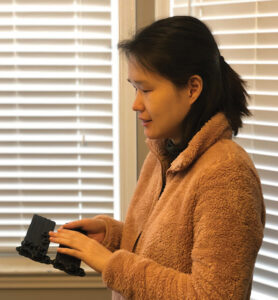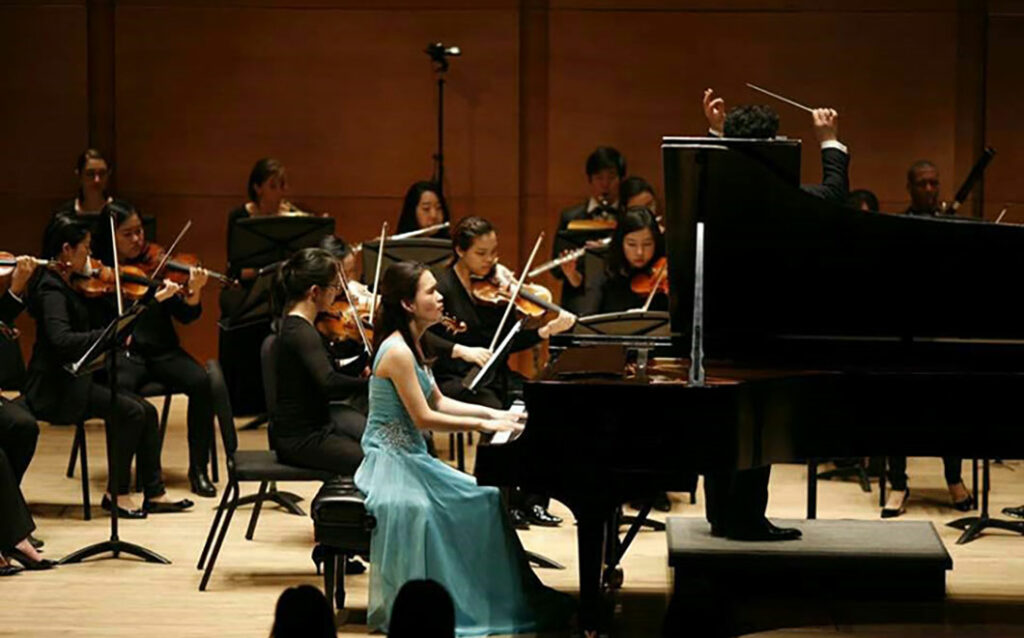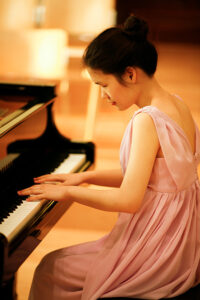
While MSU graduate student Yoo Jin Noh is working on her Doctor of Musical Arts degree in piano performance, she is also spearheading an effort to create a new music system to help non-sighted musicians and their instructors.
While overcoming the daily challenges of being blind since birth, Yoo Jin Noh found an additional hurdle the moment she sat down for her first piano lesson at age 14: references in print music that didn’t exist in braille. Note values were written differently. So were voicings and dynamics. Sometimes the disparities were too immense to clearly understand.
Despite the obstacles, Noh exceled as an award-winning soloist and student. Today, she’s collaborating with her lead professor and a resource program at Michigan State University to create accessible materials for blind students and sighted teachers as part of her lifelong quest to expand inclusivity in music instruction.
Noh, a DMA candidate in piano performance, is designing a tactile music system for blind and visually impaired music students that involves positioning 3-D printed musical elements on flat surfaces that feature five-line staffs.
“For the longest time, I wanted braille readers to have knowledge of what print music looked like and to have those two different perspectives,” Noh said. “Braille music is written character by character in a linear format. This tactile system gives musicians an actual physical map that reflects musical shapes and values.”
By using the system, non-sighted musicians could more easily learn, interpret and compose melody, and collaborate with their sighted teachers by creating an analog “roadmap” of a composition or simple musical piece.
“My biggest hope is that this system will open doors for blind people to work with sighted learners or teachers,” Noh said. “I hope, too, that marginalized blind populations can make the most use of my project for therapeutic and leisure activities.”

Yoo Jin Noh has regularly reached out to communities through music, having performed at numerous senior centers, churches, and retirement homes in addition to her solo and orchestral performances.
Seeing the difference

Yoo Jin Noh began playing piano at age 14 and has since performed with numerous orchestras and as a soloist.
For Noh, music is what taught her concepts like brightness and darkness. Her parents supported her interest in music, and it became a gateway for self-expression.
Though age 14 is relatively late for accomplished pianists to begin their training, Noh’s talent was quickly recognized. She won numerous awards through local, regional and national competitions and studied at the New England Conservatory of Music where she earned bachelor and master of music degrees and a graduate diploma.
She arrived at MSU in 2017 as a University Distinguished Fellow to study with Deborah Moriarty, professor of piano and chair of the MSU Piano Area. Today, she is collaborating with Moriarty and others at MSU on her tactile music project and recently won funding for her idea by earning the top $2,500 prize in the annual Running Start Competition through the MSU College of Music.
Moriarty said Noh is sensitive, hard-working and plays with a beautiful sound. She remarked that Noh has always expressed interest in doing something to help non-sighted people in music, particularly in terms of bridging the gap between written music and braille.
“We discussed how braille is completely different from written music, and how a non-sighted student has a copy of a musical piece that has no relationship to what the teacher is teaching from,” Moriarty said. “Braille is linear. You’re essentially learning one line of music at a time. Printed music is quite visual. For instance, if you see something going up, it’s going up. If it’s going down, it’s going down.”
Moriarty listened as Noh described her idea for a system that enabled non-sighted people to read music like sighted musicians. After the two tested out a couple ideas, Moriarty encouraged Noh to contact MSU’s Resource Center for Persons with Disabilities to explore taking her tactile system for beginning students to the next level.
“I was so fascinated to find this resource at MSU,” said Noh. “The director, Michael Hudson, is extremely aware of the needs of blind students. Many of the resources and support I needed for my project were there.”
Noh is in the initial stage of design. She’s received support throughout the process from the staff and volunteers at the resource center. The MSU Tower Guard—a student volunteer network—has also assisted Noh, in keeping with their mission to facilitate the academic success of students with visual impairments.
To date, Noh has fashioned a prototype that emulates five-line staff and musical notation using fabric, lanyards, and 3-D printed musical shapes attached with Velcro. The kit consists of a fabric board and an assortment of musical notes and symbols. Her long-term goal is to create a tactile kit that pairs a metal board with five-line staff with removable magnetic shapes.
“Winning this competition and receiving so much support from MSU is a huge encouragement for me to go on to pursue helping the blind and visually impaired,” Noh said. “I’m so grateful I found a path to contribute things from my perspective as a blind person.”

This early prototype of Yoo Jin Noh’s tactile music system shows the intent to create music that non-sighted people can feel. Her long-term goal is a tactile kit that pairs a metal board with five-line staff with removable magnetic shapes.
Challenging assumptions
As the director of career services and music entrepreneurship in the MSU College of Music, Christine Beamer coordinates the Running Start program and competition that led to initial funding for Noh’s creative idea. She said Noh’s entry typified the innovative quality of this year’s competitors, who were looking to challenge assumptions, improve access to participation, and address inequities and disparities in the music industry.
Twenty proposals were submitted for the eighth annual competition, the highest number ever. That increase, Beamer said, reflects the creative drive of students, despite the tough constraints imposed on musical studies and performance by the pandemic.
“Constraints can often spur creativity,” she said. “That’s not to minimize the devastating effect the pandemic has had on the arts and on music students, but to show that despite everything, the pandemic has also led students to challenge assumptions in our field, and to think about new methods, new formats and new opportunities in music.”
In addition to Noh’s project, the Running Start Competition live pitch featured entrepreneurial projects related to sign language and choral performance, concert wear, collaborative music platforms, subscription boxes for reed players, commissioned works, and online educational series.
“This year’s projects reminded us to ask, ‘who is not at the table in our industry, and how can we change our practice to help them feel like they belong,’” said Beamer. “Yoo Jin not only presented a convincing pitch, her participation taught us a lot about how to ensure the competition was accessible to people of all abilities and improve our own practice in supporting student entrepreneurs of all abilities.”





